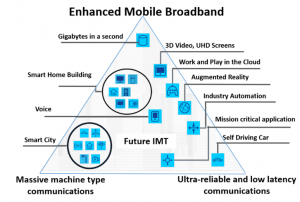In the first of a two-part article, Jon Baldry, the marketing director of Infinera, explains that, with the recent release of latest 3GPP 5G New Radio (NR) standards and the first true 5G networks potentially coming on stream in 2018, 5G-ready transport networks continue to evolve into semi-unmapped territory.
The forthcoming generation is not a forklift replacement so much as an extension and evolution of existing 4G mobile transport infrastructure – but waiting is not an option. Looking closely at their infrastructure through a 5G lens, go-ahead mobile operators see opportunities to ensure that all upgrades and extensions will be steps in the right direction – towards the 5G future.
With the first commercial 5G rollouts now announced for 2018, it is highly likely that we can expect the first 5G handsets to be announced at next year’s Mobile World Congress, now rebranded MWC19, – initially at a premium price for people who would demand the ultimate despite minimal 5G network availability. It’s human nature – like desiring a Ferrari in a world with blanket 70mph speed limits.
It will make headlines, for sure, but the real news is not so obvious. With the transition from 2G to 3G to 4G the public has got used to the idea that a new standard means a whole new network, with providers competing to be the first to roll it out. Operators are still vying to be first to market with 5G, but this time we are not replacing the 4G network, we are extending its reach into smaller 5G cells and evolving towards new 5G standards. From the outset, 4G was not set in stone: ever since its launch there have been a continuing series of further 4G releases to add new functionality, many of them geared towards supporting new 5G networks.
Why 5G?
The real driver for 5G is not a single set of applications, but a broad group that are typically clustered around one of three centres of gravity:

Figure 1: The 5G services ecosystem source: ITU-T
Enhanced broadband naturally extends the capabilities of 4G bandwidth per user to enable 5G to challenge in the residential and business broadband markets. 5G will deliver at least ten times faster than 4G to enable cloud storage of HD video clips and support for 4K video.
Massive machine type communications (MTC) is geared towards the Internet of Things (IoT) with up to a million connections per square kilometre, or 100 devices in a room, where 4G now manages a few thousand per cell. Although initial IoT deployments have majored on a population of very simple devices such as traffic sensors and smart meters sending and receiving relatively tiny pulses of data, these are just the ripples preceding a potential tsunami.
Connecting surveillance cameras to the system will add a lot of traffic, but it is forthcoming ultra-reliable and low latency communications applications such as driverless cars, industrial control and telemedicine that will really pile on the pressure. These applications require secure communications that never fail, with network latency dropped by a factor of 10 from 4G standards to an impressive 1ms to give undetectable response times.
Many of the envisaged 5G services will use a blend of these capabilities, for example virtual reality (VR) will require both high capacity and ultra-reliability with low latency. VR is more than just a game: it has potential to transform education, training, virtual design and healthcare. If a surgeon is to diagnose accurately, or even perform a remote operation, the resolution of the virtual reality image must be close to the resolution of a human retina. This requires at least 300 Mbps, almost 60 times higher than current HD video, with undetectable latency and of course ultra-reliability.
These are the sort of facts, figures and exciting applications that make the headlines. The real work, however is to provide a whole network that can support such service levels. What does this mean for the mobile provider who already has a huge investment in 4G infrastructure?
How to get there
5G achieves its massive bandwidth by operating on higher frequency bands, in the millimetre wave spectrum. At these frequencies the signals do not travel as far and they are more readily obstructed by walls, obstacles, rain or mist, requiring clear line-of-sight access.
A slow download to a smartphone, or a break in a phone conversation, is annoying but seldom disastrous – and earlier technologies were no better. Extreme reliability is, however, essential for driverless cars or other critical 5G services. We cannot afford any blind spots, where a building shadows the signal.
Full availability means that many more smaller cells must be added to the network. Existing 4G access must be extended like capillaries in a fine network of small cells feeding back to existing transport arteries. This requires a huge investment, partly compensated by the fact that 5G antennae can be much smaller and use less power. They will also conserve power by focusing signals more accurately rather than beaming equally in all directions at once.
To support this more dynamic cell behaviour, we need greater intelligence towards the edge. As well as using multiple antennae to aim signals more efficiently, 5G will also recognise the type of signals being sent and reduce power when less is needed. Having a host of small cells in close proximity also enables Coordinated Multi-Point (CoMP) – a technique whereby nearby base stations respond simultaneously and cooperate to improve quality of service.
While the new radio access network does its best to minimise latency, it comes to nothing if some signals have to travel all the way to and from a distant datacentre. So another trend will be for Mobile Edge Computing (MEC) – where caching, compute power and critical applications will be pushed closer to the network edge to reduce latency and congestion in the transport network and optimise quality of service.






